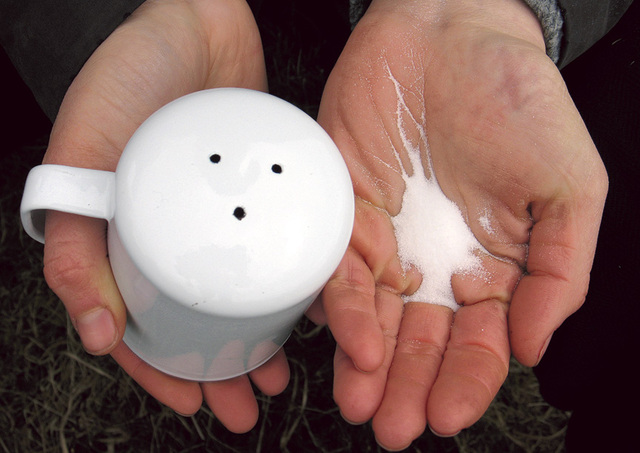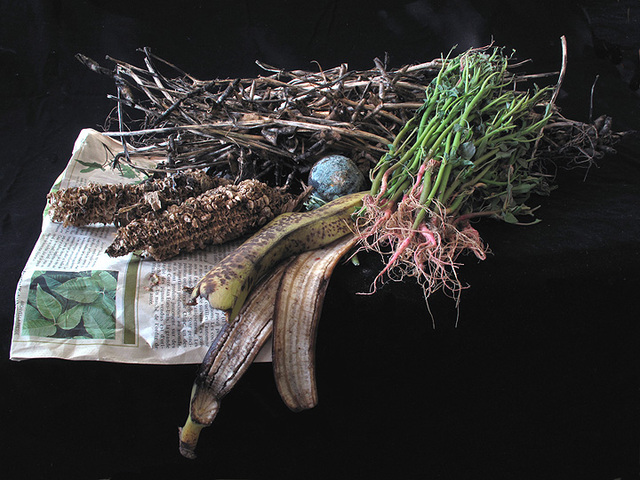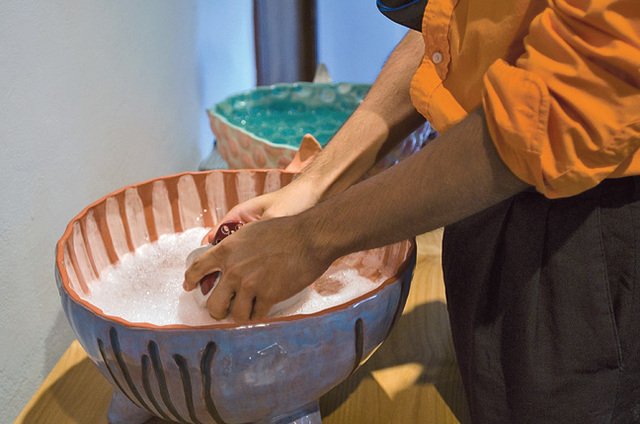Ten summers ago, UNM Art Professor Bill Gilbert invited his students on a 50-day field exploration of the Land Arts of the American West, from the ancient petroglyphs of Chaco Canyon to the contemporary carvings of Roden Crater. Every year since, he has repeated the journey.Through Dec. 20, the campus is an easel for Dispersal/Return, a group show of the field program’s alumni. A series of performances, participatory events and film screenings is in progress and open to the public. A steel, Plexiglas and compost greenhouse—“Culture Digest(e)," conceived by Nina Dubois and Jeanette Hart-Mann—is a living structure with grass growing from its roof; it stands in the plaza before Popejoy Hall. And in the UNM Art Museum, there is a breathtaking array of artistic expression.By virtue of superb curatorial consideration, traveling in a circle around the gallery will introduce you to works representative of sun, earth, sky, sea and spirit. Jeff Beekman’s "Cauterized Globe" addresses the cartographer’s construction of spatial reality—and what happens when the names that define it are erased. "2749 Years for Matchsticks"—Erika Osborne’s painstaking, 15-foot-long graphite drawing of the cross section of a sequoia—is composed on a series of oversized matchbooks and illuminates the problematic centrality of wood to our lives. The breeze that kisses you as you move through the exhibit originates from Yoshimi Hayashi’s "Helms Alee," a billowing sail installation that, with its sedentary video and sculptural components, explores the kinship of wind and spirit—and the obstacles both face in the urban environment.Students inclined to participate in Professor Gilbert’s program are of a certain personality; it’s not just anyone, after all, who has the fortitude to spend seven weeks in extreme and unpredictable conditions. These are artists dually devoted to their craft and their environment, micro and macro. Perhaps it should be no surprise that they engage themes born of a common consciousness. Yet it is astonishing to witness how disparately this consciousness is realized by each individual. Take, for vivid example, the life and work of Brooke Steiger, who participated in the inaugural American West program during her MFA candidacy. Though a Master Printmaker by Tamarind training, Steiger pursues her artistry in myriad forms. Among other media, her body of work encompasses acrylic on paper, metal-armature marionettes and three-dimensional constructions. So her space is designed to accommodate a broadly realized, yet tightly defined, aesthetic vision. Steiger’s Nob Hill house is her studio and her studio, her house; every inch of every room is like a canvas—a still life of objects found, made and in progress—pristinely composed because, she says, “that’s just how I see things.” With the encouragement of her parents and the inspiration of the Oregonian countryside, Steiger spent her childhood drawing, painting and building the tangible extensions of her imagination. Over time, her innate connection to her environment bloomed into a holistic creative ethic focused on “nature and humanity and beauty.” Now art is the primary language by which Steiger responds to the world. Her process and her intent are deeply intertwined. Steiger describes herself as inherently scattered; at any given moment, she may have hundreds of projects going. Her productivity relies on solitude, tranquility and the elasticity of time—which, she believes, can be achieved by centering herself on a “certain way of being.” Steiger’s work has a calming effect on the audience; from her meditative pursuit of fluidity and serenity emerge visual objects with these very characteristics—two of which can be seen in Dispersal/Return ."The Twins," the product of inspiration found as she “watched a storm cross the desert,” is Steiger’s rumination on the polarity of nature. A blooming cloud made of cleverly interpreted tulle hangs in complement to hand-strung, thousand-beads-long strands of “rain.” This storm’s delicate incarnation sets the backdrop for a winged puppet of dual spirits: Human and Avian. "Robin," another dually spirited creation, sits atop a fantastically devised tree house and speaks to both the personification of animals and the animalism of people. When Steiger imagined the UNM show prior to its opening, she hoped that each participant’s pieces would “be able to sing their little song” in harmony with those around them. Upon entering the exhibition, you will encounter an artistic chorus because, as Steiger explains, all involved “share a perspective. Even though individual experiences may be completely different, being on that trip was singular.” Indeed, the artists and their work are bound by shared adventure, by a collective psyche that reveres and revels in nature. Their bond is beautiful to behold.
Dispersal/Return: Land Arts of the American West 2000-2006
Opening reception, Friday, Sept. 25, 5 to 7 p.m.
Show runs through Nov. 25
UNM Museum (in Popejoy Hall)
unmartmuseum.unm.edu277-4001












